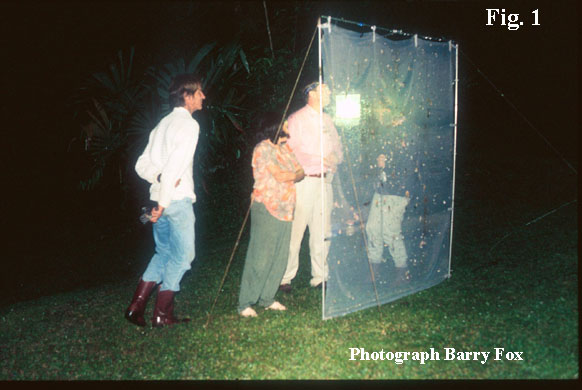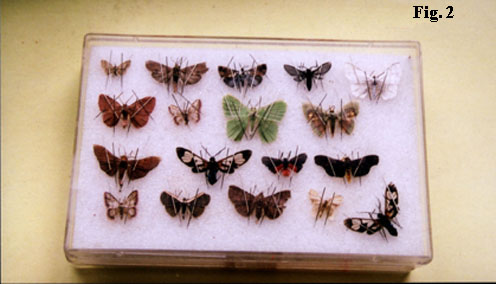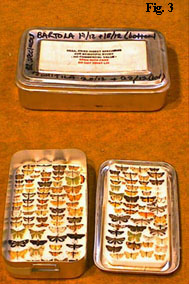 |
My collecting in Belize to date has consisted of four six-week expeditions in December/January of 1997/98, 1998/99, 1999/2000 and 2000/2001, with further trips planned. The localities in Belize I have collected at to date are marked on the map. They include Greenhills Butterfly Farm, Mile 8, Mountain Pine Ridge Road, Cayo District (noted as 'Greenhills' in this catalogue) where I collected extensively in both 1997/98 and 1998/99; Pook's Hill Jungle Lodge, Teakettle Village, Belmopan, where I collected extensively in 1997/98, 1998/99, 1999/2000 and 2000/2001; and Maya Beach, Placencia, Stann Creek District, where I did a little collecting in 1997/98, 1998/99, 1999/2000 and 2000/2001. Localities collected additionally in 1998/99 included Lamanai Jungle Lodge (and the ruins of Lamanai itself) in Orange Walk District; the field studies centre of Programme For Belize at La Milpa, Orange Walk District; and the No. 1 Resthouse at the Forestry Department's Douglas da Silva Forestry Station at Augustine in the Mountain Pine Ridge Forest Reserve. In 1999/200 I was able to do further collecting at da Silva and collected for the first time at the Natural History Museum of London's field station at Las Cuevas (both extraordinarily rich sites) and at Fallen Stones Butterfly Ranch, Lubaantum in southern Toledo. Further collecting was done at Las Cuevas and Da Silva in 2000/2001. Some collecting was done at du Plooy's Jungle Lodge in Cayo in 1999/2000, but this was limited due to dry conditions. In 2000/2001 I collected for the first time at Wilson's Landing near Punta Gorda, in Toledo, a potentially very rich site, where accommodation was kindly provided by Pat La Follette.
Automatic moth traps give very unsatisfactory results in the tropics
as the heat causes the moths to become extremely agitated in the trap
and they turn themselves into a greasy mass of badly rubbed specimens
overnight. As a result I use
the technique of 'sheeting' first shown to me by Bernard Lalanne-Cassou
and used by him in the Caribbean and French Guyana. My own sheeting apparatus
- illustrated in action below (fig. 1) -
was home-built specifically for the job of collecting in the jungle
and consists of a lightweight,
collapsible aluminium framework like a soccer goal
which, when assembled, is used to support a white nylon mesh held to the frame
by velcro quick-release strips. A gibbet at the top of the frame supports a 160 Watt
blended Mercury Vapour bulb about 30 cm from the front of the mesh and between
50 and 60 cm from the top of the frame. The whole apparatus collapses into a stuff-bag
50 cm long and 12 cm in diameter and can be
assembled/dis-assembled in the jungle,
with practice, in under ten minutes. The Mercury Vapour Bulb is protected from rain
(which would cause it to shatter instantly when hot) by an excellent rain-shield
made by Bioquip products of California. The bulb is powered by the remarkable
Honda EX350 2-stroke/2-cycle generator which, unfuelled, weighs only 8.5kg and
can run for up to four hours on one tank of petrol/gasoline.
For the sake of peace and quiet the generator is run at a distance of 20 metres
or more from the trap using an electrical extension cable joined to the bulb by
submarine electrical connectors. The generator is protected from rain by a waterproof
collapsible plastic 'tent' made from a large builders' rubble disposal bag.
 |
Macromoth specimens (above about 2 cm in wingspan) are killed as they are picked off
the 'sheet',
using ethyl acetate
and a large number of killing jars to minimise 'rubbing'. The specimens are then
'papered' in gummed-flap
glassine envelopes (used by stamp collectors among others) bought in bulk from a
stationers in the U.K. Full data are written on the envelope and the envelopes
and specimens are thoroughly dried in 'tupperware' or similar boxes using several
changes of self-indicating silica gel. As extra security against mould/mold
a little powdered thymol is added to each box. The boxes are shipped back under
export permit to the U.K. (see conservation)
where they are 'relaxed' and mounted in the usual way.
Smaller 'microlepidoptera'
will not easily rehydrate and must be taken off the sheet and stored alive
in glass tubes overnight. In the morning they are freshly killed with ethyl
acetate and, while still soft, immediately
field-mounted using the 'plastazote' technique.
Up to 30 microlepidoptera may be mounted in each 12cm x 8cm x 2cm plastazote
box (fig. 2); the dead specimens are dried with silica gel while pinned in the plastazote boxes
and then unpinned from the plastazote and re-pinned into tough aluminium
boxes (fig. 3) for transport back to the U.K. Pests have never been a problem to date
as all
specimens are stored at all times in tightly-sealed 'tupperware' boxes
 |
 |
Apart from the 1993 British Joint Services Expedition to the Upper Raspaculo River, and the 1996, 1997 and 1998 British Entomological and Natural History Society's expeditions to Belize I can find no references in the recent literature to moth collecting in Belize. Older references to Belizean moths, apart from specimens sent to the British Museum by Blancaneaux, White, Moloney and others at the turn of the century also appear to be very scarce. I have unearthed no publications to date on macro-moths resulting from work at the Natural History Museum's field station at Las Cuevas, but these will undoubtedly appear in time.
Jan Meerman, of Greenhills butterfly ranch, having substantially documented the Belizean butterfly fauna, has recently produced a catalogue of all the Belizean Sphingidae and Saturniidae know to date (Meerman 1999). Apart from this, the rich Belizean moth fauna is largely undocumented: I would 'guesstimate' that there may be up to 8,000 species present (see 'species number estimates)'.
This catalogue represents only a very preliminary progress
report on my efforts to date, containing many partial or
provisional identifications (many of which will turn out
to be 'new', undescribed, species). Almost all of the species captured
in 17 of the 20
families of larger moth are listed - however, due to lack of time
and resources I have not yet been able to identify all species caught in the
three large families Geometridae, Noctuidae and Notodontidae.
As identifications become available I hope to add these species to the catalogue.
As there will doubtless
be mistakes at this early stage I plan eventually to include colour
illustrations of all of my captures so that others with better
resources can build on my work. The dynamic nature of the internet lends itself well
to biodiversity studies, which, like their subjects, are in a continual state
of evolution. I hope that my modest efforts will stimulate further interest in this
fascinating region and its diverse moth fauna and that others will be stimulated to
offer additions and corrections and produce similar works for other tropical regions.
There are currently too few entomologists for the number of insects on the face of
the earth. Unless we do something NOW to catalogue - and hence help to conserve -
tropical insect faunas this situation may rapidly reverse itself.